Temporal and spatial patterns of endogenous danger signal expression after wound healing and in response to lymphedema
- PMID: 21248077
- PMCID: PMC3093946
- DOI: 10.1152/ajpcell.00378.2010
Temporal and spatial patterns of endogenous danger signal expression after wound healing and in response to lymphedema
Abstract
While acute tissue injury potently induces endogenous danger signal expression, the role of these molecules in chronic wound healing and lymphedema is undefined. The purpose of this study was to determine the spatial and temporal expression patterns of the endogenous danger signals high-mobility group box 1 (HMGB1) and heat shock protein (HSP)70 during wound healing and chronic lymphatic fluid stasis. In a surgical mouse tail model of tissue injury and lymphedema, HMGB1 and HSP70 expression occurred along a spatial gradient relative to the site of injury, with peak expression at the wound and greater than twofold reduced expression within 5 mm (P < 0.05). Expression primarily occurred in cells native to injured tissue. In particular, HMGB1 was highly expressed by lymphatic endothelial cells (>40% positivity; twofold increase in chronic inflammation, P < 0.001). We found similar findings using a peritoneal inflammation model. Interestingly, upregulation of HMGB1 (2.2-fold), HSP70 (1.4-fold), and nuclear factor (NF)-κβ activation persisted at least 6 wk postoperatively only in lymphedematous tissues. Similarly, we found upregulation of endogenous danger signals in soft tissue of the arm after axillary lymphadenectomy in a mouse model and in matched biopsy samples obtained from patients with secondary lymphedema comparing normal to lymphedematous arms (2.4-fold increased HMGB1, 1.9-fold increased HSP70; P < 0.01). Finally, HMGB1 blockade significantly reduced inflammatory lymphangiogenesis within inflamed draining lymph nodes (35% reduction, P < 0.01). In conclusion, HMGB1 and HSP70 are expressed along spatial gradients and upregulated in chronic lymphatic fluid stasis. Furthermore, acute expression of endogenous danger signals may play a role in inflammatory lymphangiogenesis.
Figures
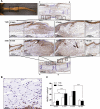

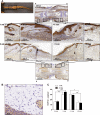
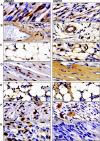


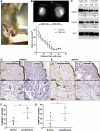
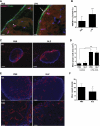
Similar articles
-
Toll-like receptor deficiency worsens inflammation and lymphedema after lymphatic injury.Am J Physiol Cell Physiol. 2012 Feb 15;302(4):C709-19. doi: 10.1152/ajpcell.00284.2011. Epub 2011 Nov 2. Am J Physiol Cell Physiol. 2012. PMID: 22049214 Free PMC article.
-
Blockade of transforming growth factor-beta1 accelerates lymphatic regeneration during wound repair.Am J Pathol. 2010 Dec;177(6):3202-14. doi: 10.2353/ajpath.2010.100594. Epub 2010 Nov 5. Am J Pathol. 2010. PMID: 21056998 Free PMC article.
-
Fibrosis worsens chronic lymphedema in rodent tissues.Am J Physiol Heart Circ Physiol. 2015 May 15;308(10):H1229-36. doi: 10.1152/ajpheart.00527.2013. Epub 2015 Mar 13. Am J Physiol Heart Circ Physiol. 2015. PMID: 25770241 Free PMC article.
-
Lymphatic endothelial cells, lymphedematous lymphangiogenesis, and molecular control of edema formation.Lymphat Res Biol. 2008;6(3-4):123-37. doi: 10.1089/lrb.2008.1005. Lymphat Res Biol. 2008. PMID: 19093784 Review.
-
Lymphatic Dysfunction, Leukotrienes, and Lymphedema.Annu Rev Physiol. 2018 Feb 10;80:49-70. doi: 10.1146/annurev-physiol-022516-034008. Epub 2017 Oct 13. Annu Rev Physiol. 2018. PMID: 29029593 Free PMC article. Review.
Cited by
-
Lymphatic function is regulated by a coordinated expression of lymphangiogenic and anti-lymphangiogenic cytokines.Am J Physiol Cell Physiol. 2012 Jan 15;302(2):C392-404. doi: 10.1152/ajpcell.00306.2011. Epub 2011 Sep 21. Am J Physiol Cell Physiol. 2012. PMID: 21940662 Free PMC article.
-
Abnormal lymphatic S1P signaling aggravates lymphatic dysfunction and tissue inflammation.medRxiv [Preprint]. 2023 Jun 12:2023.06.08.23291175. doi: 10.1101/2023.06.08.23291175. medRxiv. 2023. Update in: Circulation. 2023 Oct 17;148(16):1231-1249. doi: 10.1161/CIRCULATIONAHA.123.064181. PMID: 37398237 Free PMC article. Updated. Preprint.
-
Galectin-1 regulates tissue exit of specific dendritic cell populations.J Biol Chem. 2015 Sep 11;290(37):22662-77. doi: 10.1074/jbc.M115.644799. Epub 2015 Jul 27. J Biol Chem. 2015. PMID: 26216879 Free PMC article.
-
Regional Patterns of Fluid and Fat Accumulation in Patients with Lower Extremity Lymphedema Using Magnetic Resonance Angiography.Plast Reconstr Surg. 2020 Feb;145(2):555-563. doi: 10.1097/PRS.0000000000006520. Plast Reconstr Surg. 2020. PMID: 31985658 Free PMC article.
-
Th2 cytokines inhibit lymphangiogenesis.PLoS One. 2015 Jun 3;10(6):e0126908. doi: 10.1371/journal.pone.0126908. eCollection 2015. PLoS One. 2015. PMID: 26039103 Free PMC article.
References
-
- Akira S, Uematsu S, Takeuchi O.Pathogen recognition and innate immunity.Cell 124: 783–801, 2006 - PubMed
-
- Andersson U, Tracey KJ.HMGB1 in sepsis.Scand J Infect Dis 35: 577–584, 2003 - PubMed
-
- Avraham T, Clavin NW, Daluvoy SV, Fernandez J, Soares MA, Cordeiro AP, Mehrara BJ.Fibrosis is a key inhibitor of lymphatic regeneration.Plast Reconstr Surg 124: 438–450, 2009 - PubMed
-
- Bianchi ME.DAMPs, PAMPs and alarmins: all we need to know about danger.J Leukoc Biol 81: 1–5, 2007 - PubMed
Publication types
MeSH terms
Substances
LinkOut - more resources
Full Text Sources
Other Literature Sources
Medical

